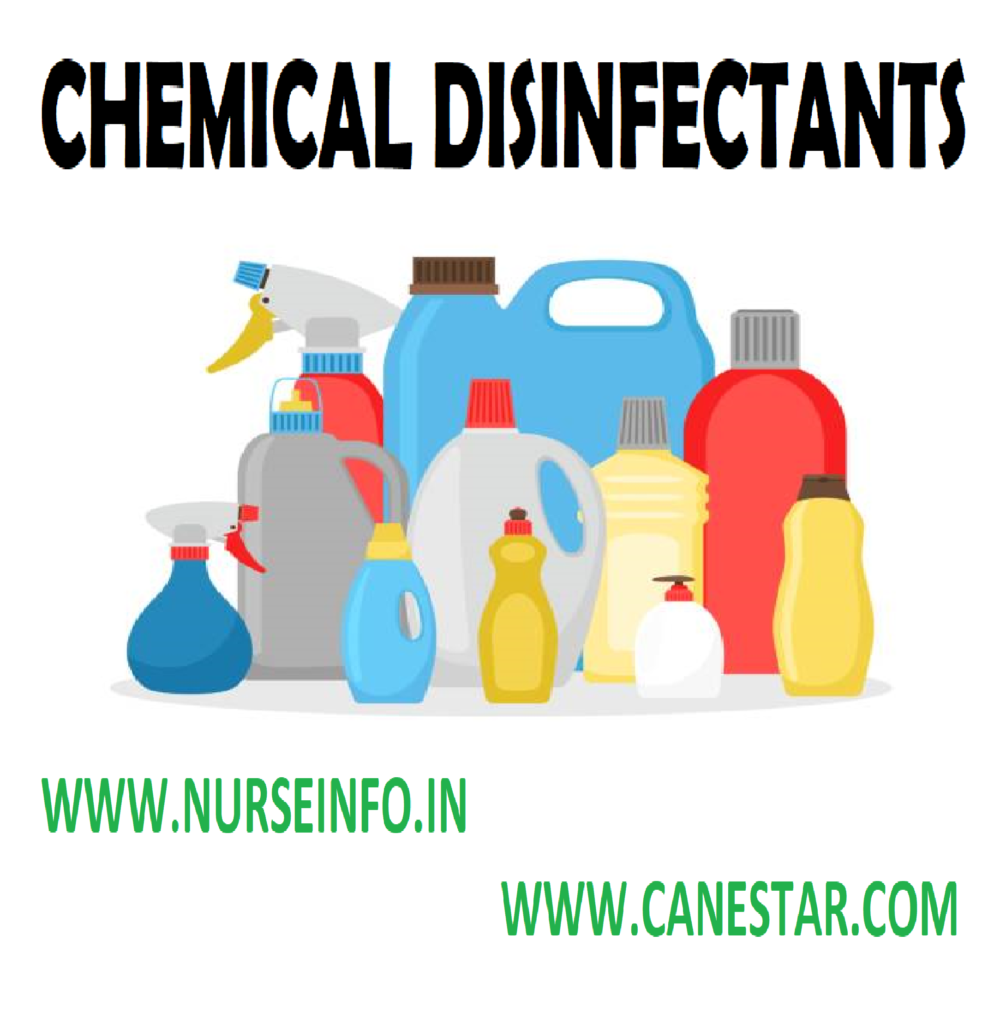Chemical disinfection is a process that involves the use of chemical agents to eliminate or reduce the number of microorganisms on surfaces, objects, or in the environment. Disinfectants are chemicals specifically designed to destroy or inhibit the growth of harmful microorganisms, including bacteria, viruses, and fungi. Here are key aspects of chemical disinfection:
Types of Chemical Disinfectants:
- Alcohols:
- Common Types: Ethanol, isopropyl alcohol.
- Applications: Used for disinfecting skin, surfaces, and small medical devices.
- Quaternary Ammonium Compounds (Quats):
- Common Types: Benzalkonium chloride, cetylpyridinium chloride.
- Applications: Widely used in healthcare settings, surface disinfection, and as antiseptics.
- Chlorine Compounds:
- Common Types: Sodium hypochlorite (bleach).
- Applications: Disinfecting surfaces, water treatment, and decontamination.
- Phenols:
- Common Types: Phenol, cresols.
- Applications: Used in healthcare settings, laboratories, and general disinfection.
- Iodine Compounds:
- Common Types: Povidone-iodine, iodophors.
- Applications: Skin disinfection, wound care, and surgical site preparation.
- Hydrogen Peroxide:
- Common Types: Hydrogen peroxide.
- Applications: Used as a general disinfectant for surfaces and skin.
- Aldehydes:
- Common Types: Formaldehyde, glutaraldehyde.
- Applications: Used in healthcare for high-level disinfection of medical instruments.
- Biguanides:
- Common Types: Chlorhexidine.
- Applications: Used as antiseptics and for skin disinfection.
Factors Influencing Chemical Disinfection:
- Concentration:
- The effectiveness of a disinfectant often depends on its concentration. Higher concentrations may be more effective but can also be more corrosive or irritating.
- Contact Time:
- The duration for which the disinfectant is in contact with the surface or material influences its efficacy. Longer contact times generally improve disinfection.
- pH Level:
- The pH of the solution can affect the activity of certain disinfectants. Some disinfectants are more effective under specific pH conditions.
- Temperature:
- The temperature at which the disinfection occurs can impact the effectiveness of certain chemical agents.
Applications of Chemical Disinfection:
- Healthcare Settings:
- Disinfection of surfaces, medical instruments, and healthcare environments to prevent healthcare-associated infections.
- Laboratories:
- Decontamination of equipment, benches, and workspaces to maintain aseptic conditions.
- Food Industry:
- Disinfection of food preparation surfaces, utensils, and equipment to ensure food safety.
- Water Treatment:
- Use of disinfectants to treat water supplies and ensure the elimination of waterborne pathogens.
- Home Disinfection:
- Disinfectants are commonly used for cleaning and disinfecting surfaces in households.
CHEMICAL DISINFECTANTS
The chemical substances known as disinfectants are used to kill pathogenic organism.
Mechanism of Chemical Disinfectants
A chemical disinfectant acts by coagulating the bacterial protein or by changing the composition of protein so that is no longer exist in the same form
Commonly Used Disinfectants
- Phenol
- Lysol
- Formalin
- Dettol
- Alcohol
The Choice of Disinfectant Based on
- The strength of the solution
- Type of bacteria to be killed
- Type of articles
- Length of exposure
- The articles should be fully immersed in the lotions
Chemical Agent, Mechanism and Uses
- Alcohols (ethanol, isopropanol)
Mechanism: denaturation of bacterial proteins
Uses: skin antiseptics, surface decontamination of incubators and cabinet interiors, disinfection of clinical thermometers
- Aldehyde (formaldehyde and glutaraldehyde)
Mechanism: inactivation of bacterial proteins
Uses: preservation of biological specimens, destroying anthrax spores in wool, fumigation.
Cold sterilant and fixative, surface decontamination, disinfection of hospital instruments, equipment, glasswares
- Biguanides (chlorhexidine)
Mechanism: damage plasma membranes
Uses: skin and mucous membrane disinfection
- Dyes (aniline dyes, malachite green, acridine dyes, acriflavine, proflavine)
Mechanism: react with acid group in cell
Impair DNA and destroy reproductive capacity
Uses: selective agents in culture media, e.g. LJ media
Skin antiseptic
- Beta propiolactone
Mechanism: damage DNA, RNA and cause alkylation
Uses: fumigation, sterilization of biological products
- Halogens (chlorine and iodine)
Mechanism: oxidizing agent and protein denaturation
Uses: surface decontamination, emergency spills clean-up, disinfectant
- Metallic salts (silver, mercury)
Mechanism: combine with sulfhydryl groups, coagulate proteins and inactivate enzymes
Uses: antiseptic to prevent against gonorrheal infections in infants
- Phenolic compounds (phenol, cresol)
Mechanism: damage to cell membranes, inactivation of proteins, oxidases and dehydrogenases
Uses: disinfectant in hospitals
- Perioxides (hydrogen peroxide)
Mechanism: oxidizing agent
Uses: disinfectant
- Quaternary ammonium compounds (zephiran, triclosan)
Mechanism: surface active agents (cationic detergent)
Uses: surface decontaminant and disinfecting equipment
- Surfactants (soaps and detergent, sodium lauryl sulphate, benzalkonium chloride, cetrimide)
Mechanism: disruption of cell membrane
Uses: detergents and wetting agents
Advantages
- This method is used to sterilize instruments which are damaged by heat and metallic objects prone to corrosion
- It is an easy method
Disadvantages
- A disinfectant cannot destroy the spores
- Disinfectants are injurious to skin and the articles
General Instruction
- The disinfectant chosen should destroy the pathogens
- It should be used in correct strength
- The article should be fully submerged it
- The article should be kept in the disinfectant for sufficient time
- The disinfectant should not be injurious to the skin and the article
- The disinfectant should be cheap
- Before dipping the article into the disinfectant clean it properly to free it from organic material


